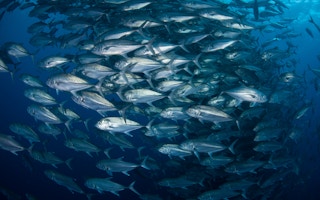In the 2013 Ocean Health Index (OHI) — an annual assessment of ocean health led by Ben Halpern, a research associate at UC Santa Barbara’s National Center for Ecological Analysis and Synthesis (NCEAS) and professor at the Bren School of Environmental Science & Management — scientists point to food provision as the factor that continues to require serious attention.
The OHI defines a healthy ocean as one that sustainably delivers a range of benefits to people now and in the future based on 10 diverse public goals. The 2013 score of 65 out of 100 demonstrates the ongoing need for more effective management of this precious resource.
“I’m encouraged because people, organizations and governments are paying attention to the Ocean Health Index and what they can learn from it,” Halpern said. “Not only has the OHI been adopted as an indicator to gauge how well countries are meeting their biodiversity conservation targets, but it is beginning to inform the United Nations World Ocean Assessment and was named by the World Economic Forum as one of two endorsed tools for helping achieve sustainable oceans.”
Goal scores out of a possible 100 for categories that make up the OHI ranged from a low of 31 for natural products to a high of 95 for artisanal fishing opportunities. Other categories include food provision (33), carbon storage (74), coastal protection (69), coastal livelihoods and economies (82), tourism and recreation (39), sense of place (60), clean waters (78) and biodiversity (85).
With a score of only 33 out of 100, food production from wild harvest and mariculture (cultivation of marine organisms in the open ocean) was the second-lowest-scoring goal and one of the most important resources from the sea for people around the world. A score of 100 is given for wild-caught fisheries if the biomass of landed stocks at sea is within ±5 percent of a buffered amount below the biomass that can deliver maximum sustainable yield. For mariculture, the number of tonnes of product per coastal inhabitant living within 31 miles of the coast is calculated for each country, and all countries above the 95th percentile receive scores of 100. Countries that have never had mariculture are not scored.
“Seafood is a major source of protein for one-third of the world’s population, and it is estimated we will need 70 percent more food by 2050 to feed the growing population,” said Daniel Pauly, principal investigator of the Sea Around Us project and leader of the University of British Columbia team of science contributors to OHI. “The score of 33 out of 100 for food provision indicates we are not ready to meet that challenge.”
The 2013 OHI also assessed coastal protection, giving it a score of 69 out of 100 and indicating that further declines are likely. Coastal habitats — including mangrove forests, sea-grass beds and salt marshes, coral reefs and sea ice — protect coastlines from storm surges and coastal flooding. Forty-five countries that sit in the annual path of tropical cyclones had an average score of 52 out of 100. A score below 100 indicates a decline in area and condition of key natural habitats that protect shorelines from storms.
Among those cyclone-prone countries with a population exceeding 10 million people, the average coastal protection score is only 51 compared to the global average score of 69. The score was down slightly (-0.2 percent) from 2012 and the OHI calculates that the likely future status will decrease by 1 percent in the coming five years.
“Restoring natural protective habitats in storm-prone regions, in combination with sensible coastal planning and creative civil engineering, is essential,” said Greg Stone, a leading authority on marine conservation policy and ocean health issues and executive vice president at Conservation International’s Betty and Gordon Moore Center for Science and Oceans.
Wealthy countries have the greatest impact on industry and policy so their performance on the OHI is important to ocean health, but there was little correlation between their economic performance as measured by gross domestic product (GDP) and their OHI scores. The average score of countries with the 15 highest GDPs was 65 — higher than the global average, but still not optimal.
“In its second year now, the OHI demonstrates that the areas with the least human impact have healthier oceans, but it also shows that nations who manage their resources better achieve higher OHI scores,” Halpern said. “We depend on the health of the ocean for many benefits, such as food, livelihood and tourism, and the OHI indicates that the condition of these benefits needs to be improved in order to provide a healthy thriving ocean for our children and their children.”








